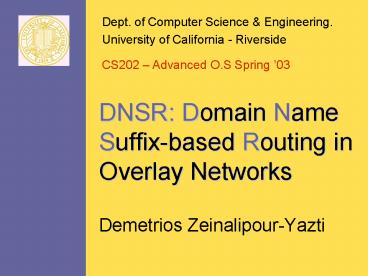DNSR: Domain Name Suffix-based Routing in Overlay Networks - PowerPoint PPT Presentation
Title:
DNSR: Domain Name Suffix-based Routing in Overlay Networks
Description:
We connect to a .rr.com host. Submit 40 queries and count the number of hosts contacted C. ... topology we will contact more .rr.com hosts than with a random ... – PowerPoint PPT presentation
Number of Views:76
Avg rating:3.0/5.0
Title: DNSR: Domain Name Suffix-based Routing in Overlay Networks
1
DNSR Domain Name Suffix-based Routing in Overlay
Networks
Dept. of Computer Science Engineering. Universit
y of California - Riverside
CS202 Advanced O.S Spring 03
- Demetrios Zeinalipour-Yazti
2
Introduction
- Most overlay networks dont match the underlying
topology - Transcontinental connections are expensive.
- It would be desirable to keep the bulk of the P2P
traffic within the same domain
3
Motivation
- Analyzing the Gnutella Network
- D. Zeinalipour T. Folias, cs204 Course
Project - We analyzed 300,000 IP addresses.
- 58.73 of Gnutella IPs belongs to only 20 ISPs.
- Organizing Peers into domains rather than loosely
interconnecting them might be feasible
4
DNSR Idea
- DNSRDomain-Name Suffix-based Routing
- Decentralized Routing Algorithm that attempts to
keep P2P traffic within the same domain. - DNSR defines three Level factors per peer
- Sibling Factor (sfi)
- Parent Factor (pfi)
- Children Factor (cfi)
- DNSR also defines a similarity function
-suffix
5
DNSR Topology
- Given that each node maintains the Level Factors
we end up with a semi-hierarchical topology.
6
Joining a DNSR Topology
- A node obtains a random list from an out-of-band
mechanism (e.g. hostcache). - It probes for best entry point with Lookup
7
Searching a DNSR Topology
- Searching can be done with a variety of
techniques (BFS, Random BFS,.) - The bottom-line with all techniques is that the
bulk of the traffic remains within the same
domain
8
Experimental Setup
- Scenario
- We generate a DNSR topology and a Random Topology
of 1000 nodes with following distributions - We deploy the 1000 real nodes on 25 machines
- We run a number of queries and observe the
distribution of hosts contacted in each case.
9
Experimental Evaluation
- Each node reads its settings from the filesystem
- All nodes are launched concurrently with ssh
public/private keys making the bootstrapping easy.
10
Experimental Results
Level 0
- We connect to a .rr.com host
- Submit 40 queries and count the number of hosts
contacted C. - In a random topology C matches the actual
distribution of hosts - In a DNSR topology most of the hosts contacted
are .com hosts for level 0.
11
Experimental Results
Level 1
- For Level 1 we can see that in DNSR topology we
will contact more .rr.com hosts than with a
random topology. - Therefore more traffic remains within same domain
- Sibling Factor was 66. If it was larger then 24
would be larger
12
DNSR Demo Follows
Dept. of Computer Science Engineering. Universit
y of California - Riverside































